Should I put LED bulbs in my headlights? Blog › Is it worth it to change conventional lamps to LED
In the autumn-winter period, daylight hours become shorter, nights are longer, and the time spent on the road with headlights on gradually increases. And how sometimes you want to add a little more brightness to your headlights on a dark road, increase the area of \u200b\u200bthe light spot and the illumination of the roadbed. Among the manufacturers of headlights and bulbs for them, the struggle is for every particle of the luminous flux. Additional "candles" should shine in a strictly defined direction - down and onto the road, and in no case in the eyes of an oncoming driver.
At the same time, the driver, having bought a car once, practically cannot change the quality of his headlights. What kind of light was installed at the factory - with that you have to go. The maximum that is subject to a motorist is the replacement of light bulbs. Understanding this, lamp manufacturers lure drivers with claims that their lamps shine 50%, 70%, or even 100% brighter than conventional halogens. Tests show these numbers are marketing ploys. Replacing regular light bulbs with sources with increased light output will not be able to give a twofold increase in light, but an increase in luminous flux will still be noticeable.
How to make the light really brighter? The answer lies on the surface, and automakers have long answered it. It is necessary to change the light source: abandon incandescent lamps in favor of gas-discharge lamps, commonly referred to as xenon. Please note: it is xenon that shines in all premium cars.
But do not think that we are campaigning to install xenon lamps simply instead of halogens. Such a refinement of the headlights, popularly referred to as "collective farm xenon", shines anywhere, but not on the road. We suggest looking at a more correct and interesting option. Now blocks of linzovannaya xenon have appeared on sale. This is a unit consisting of a discharge lamp, a reflector and a projection headlight. Moreover, this headlight is proposed to be installed directly in the block headlight of the car. How to do it yourself is described in our other article, and here we will compare the result.
Additional measurements
Now it has become fashionable to install LEDs in all possible places of the car. Some Chinese craftsmen offer to put them even instead of headlights. Since they offer - we will try and measure whether they shine well.
How We Tested
When preparing the test, the car was put on a flat, dry asphalt surface. Signal cones were placed along a flat line from the right headlight after 10 meters.
To evaluate the work of the car's optics, the illumination of the road surface was measured.
A comparative test of standard halogen lamps and LED lamps took place on one day, then the test car went to install linzovannaya xenon. After adjusting the headlights, the second cycle of measurements was carried out - already new headlights with xenon light.
Test results
Comparison of the light spot from different light sources. On the left - regular light, halogen incandescent lamps, in the center - LED lamp installed in standard optics, on the right - linded xenon Xenite L-03 embedded in the standard headlight unit.

The pedestrian is located at a distance of 10 meters from the bumper of the car.

The pedestrian is located at a distance of 20 meters from the bumper of the car.

The pedestrian is located at a distance of 30 meters from the bumper of the car.
Worst of all were LED lamps. Although visually the light spot appears bright, it is significantly reduced even compared to the stock light. There is no need to talk about any increase in illumination from these lamps. The light spot during the installation of LEDs was sharply reduced, its far boundary was only 10 meters away, while for regular light it is 25 meters, and for lint xenon - 30 meters.
Lensed xenon pleased with their work. The visual boundaries of the light spot increased noticeably, and the illumination of the roadside also increased. At the same time, there is no complete illumination of the front space, as happens when replacing an incandescent lamp with a gas-discharge one, but there is a clearly defined border of the light spot, as required by the rules.
Evaluation of the glare of oncoming drivers from headlights with lensed xenon showed that it does not exceed the level of glare from standard incandescent lamps.
For comparison, here are photographs of a light spot with a pedestrian on the side of the road at various distances from the car. The distance between signal cones is 10 meters.
Separately by numbers.
If you look at the table, you can see that LED lamps are on average ten or more times inferior in brightness to standard incandescent lamps. If we are talking about lensed xenon, then measurements have shown that it is on average 30% brighter than standard light.
|
Table of illumination at the surface of the earth |
|||
|
Distance to bumper, m |
Illumination, lx |
||
|
Established halogens |
Lens xenon |
LEDs |
|



Diagrams comparing road surface illumination from different light sources: standard light - halogen incandescent lamps, LED lamps installed in standard optics, lint xenon Xenite L-03 embedded in the standard headlight unit.
The diagrams are for distances from the vehicle of 10, 20 and 30 meters.
conclusions
The conclusion from our test suggests itself. Playing with the replacement of headlight bulbs from incandescent bulbs to LED bulbs today is simply dangerous due to very poor illumination. But tinkering with replacing halogen lamps in standard optics with lensed xenon is worth it. This replacement gives a tangible gain in the illumination of the road, and the light remains safe for others, as it does not blind oncoming drivers.
LENSED XENON Xenite L-03
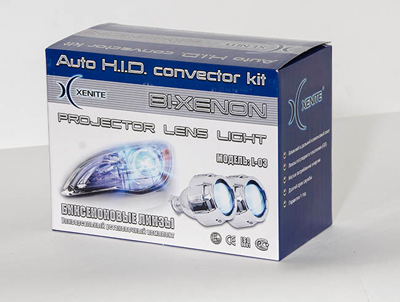
DESIGN FEATURES
Of course, the phrase "lensed xenon" is jargon, but it capaciously and accurately reflects the specifics of this technical solution. Xenite L-03 uses a gas discharge xenon lamp as a light source. At the same time, its difference from the “collective farm xenon” is that the lamp is located in an optical system specially created for it. This "packaging" is the strength of these lamps. At the same time, they can no longer be called lamps themselves: this is an almost finished headlight, but only without an outer case. The sellers and installers of these systems assume that the xenon lamp, along with the lens, crashes into the headlight instead of the standard lamp.
Briefly about the procedure for installing linzovannaya xenon Xenite L-03. You need to disassemble the headlight, cut a hole in the back for the lens, and then fix it. Before starting installation, make sure that the “depth” of the headlight canopy will be sufficient to accommodate the new component.
It should be noted that the adjustment of the headlamp glow after installation is carried out by means of a lens. At the same time, the headlight tilt electric corrector (if the car is equipped with it) remains operational.
GLOW
The first thing that was noticed when evaluating the light spot created by the Xenite L-03 linsed xenon is the cut-off line (popularly known as a “jackdaw”) that is distinguishable by the eye. That is, the boundary between the lower zone of the light flux, where it should fall, and the upper zone, where there should be no light (so as not to blind other road users).
A confident light spot is formed by lint xenon at a distance of 5 meters from the car, and a clear distant border is confidently located at around 30 meters. The illumination of the roadside and far-reaching pedestrians has significantly improved, which can be clearly seen in the photographs.
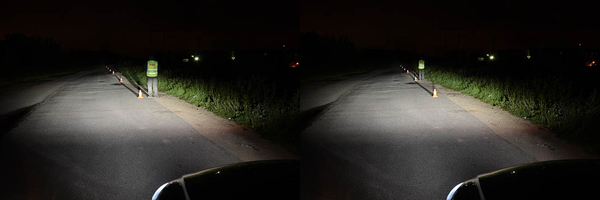
Illumination of the roadway, roadside and pedestrian in a vest with reflective elements at a distance of 10 and 20 meters from the car.
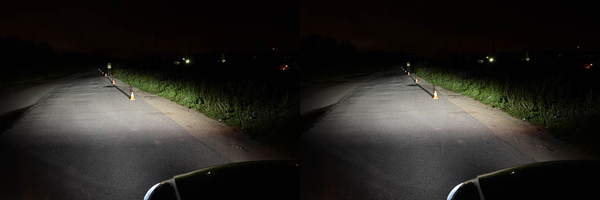
Illumination of the roadway, roadside and pedestrian in a vest with reflective elements at a distance of 30 and 40 meters from the car. Lensed xenon Xenite L-03 embedded in the regular headlight unit.
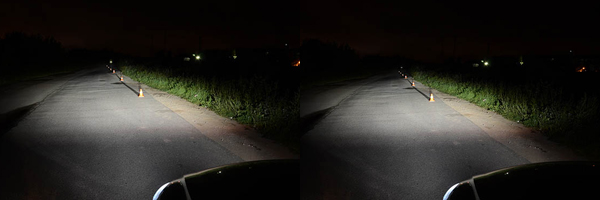
Illumination of the roadway, roadside and pedestrian in a vest with reflective elements at a distance of 50 and 60 meters from the car. Lensed xenon Xenite L-03 embedded in the regular headlight unit.
LED headlights
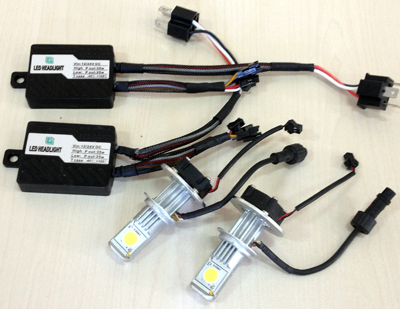
DESIGN FEATURES
The lamps themselves are two assemblies of LED crystals located on an aluminum radiator. The glow blocks are located on both sides of a thin plate, which is inserted into the headlight reflector instead of an incandescent lamp. When fixed in the headlight, the LED light source is oriented in such a way that one side of the plate shines into the bottom of the reflector, and the other into the top. On the back of the lamp there is a cooling radiator, to increase the efficiency of which, forced airflow is also used with the help of a cooler.
GLOW
LED lamps shine mercilessly - so that the eyes are blinded. The fact is that the quality of the glow of the headlight is not limited to just one light bulb. Farah is complicated focused optical system. And the word "focused" is the key here. Even a small shift of the filament out of focus or an increase in its size leads to a change in the glow of the headlight (and the account here goes to millimeters). And what will happen if we replace the halogen lamp, which is a point source of light, with a distributed one - even in the form of a gas discharge lamp (xenon), we know well from the experience of using "collective farm xenon". The luminous flux from such a lamp is so wrong that it does not illuminate the road properly and blinds oncoming drivers and passing drivers. This was the reason for the complete, legally enshrined ban on its use in this form.
Installing LED lamps leads to an even more "amazing" result. They shine much weaker than all other light sources, and they blind oncoming people much more than they illuminate the road.
The photograph clearly shows that the farthest visible to the eye boundary of the light spot is located at a distance of 10 meters from the bumper of the car. These bulbs don't light up at all! At the same time, on standard lamps, the light spot begins at a distance of about 5 meters from the bumper and confidently extends to the mark of 20 meters, and objects with retroreflective elements are visible at a distance of up to 60 meters. When replacing standard lamps with LEDs, even the reflective cones “disappeared” already at a distance of 30 meters.
Measuring the illumination of the road surface at the same time, on average, was more than ten times worse than from standard incandescent lamps.


Illumination of the roadway, roadside and pedestrian in a vest with reflective elements at a distance of 30 and 40 meters from the car. LED lamps installed in regular optics.
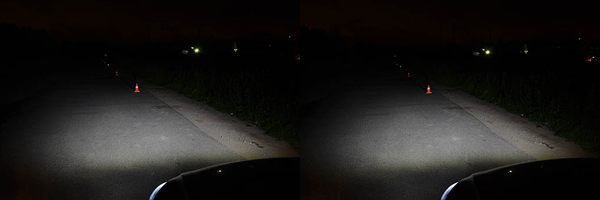
Illumination of the roadway, roadside and pedestrian in a vest with reflective elements at a distance of 50 and 60 meters from the car. LED lamps installed in regular optics.
Greetings dear readers. I got tired of these questions and examples that the neighbor goes and is happy with everything. I will try to bring to you what kind of crap this is and why you should not pay attention to it, and even more so think about acquiring it.
I must say right away that I will not consider decorative lamps for illumination reflector with many low-power LEDs.
H4 halogen bulbs with LED assembly
Such assemblies are made for the exhibition in order to beautifully illuminate the reflector or lens with the least energy consumption. You can watch a video with similar lamps in the headlight.
Halogen lamp light and LED assembly
And so the latest LED lamps for H7 / H4 socles and the like contain one or a pair of ultra-bright chips, they look like this. At the same time, it is believed that the larger the chip, the better it shines.
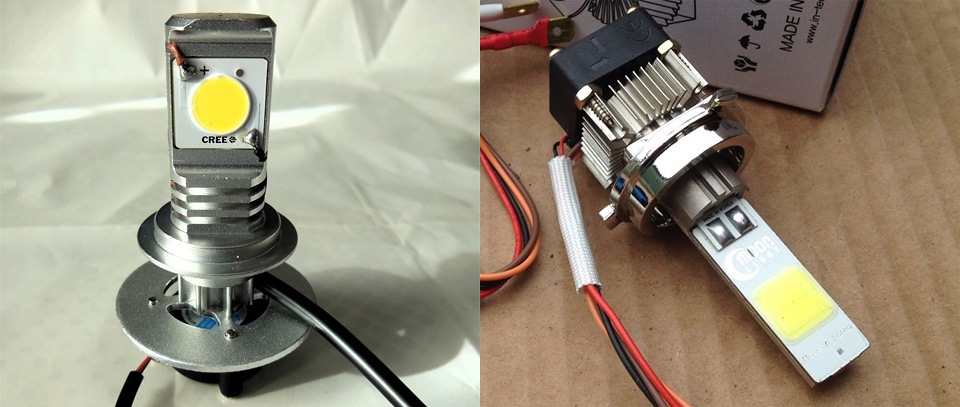
LED crafts for H7/H4 bulbs
All of you know what an incandescent spiral looks like, and it is not a secret for you that the light shaper - the reflector is calculated based on the dimensions of this light source.
Halogen reflector and H7 lamp lens
For example, here are two chips used in optics specially designed for LEDs from well-known manufacturers. What do they remind? That's right - a filament - this is how it is easier to place and calculate the LED light source.

Osram and Philips LED car light chips
And here is how they shine in low beam modules designed for these particular chips - a completely correct light distribution.

LED low beam
And so, according to physics - to the focus of the reflector, that is, in other words, to emit photons exactly where you need only a small strip on a large Chinese LED chip. The rest of the chip will shine anywhere, but not in the right direction.
What will shine where it should
Moreover, it turns out that the side parts of the reflector are just responsible for the formation of the light-shadow border, and everything on top is for the light in front of the car. That is, purely theoretically, putting this lamp in a conventional H7 lamp reflector, we lose light in the distance. At all.

Light distribution in the reflector of LED lamps
Now let's move on to practice. I'm not an idiot to buy similar fixtures myself, so everything is taken from the Internet. So let's start by watching the video:
As you can see the LED lamps in simple reflector they shine less intensely than halogen ones and create a light right in front of the car like normal PTFs. Are you ready to lose your neighbor?

Comparison of halogen lamp and LED light
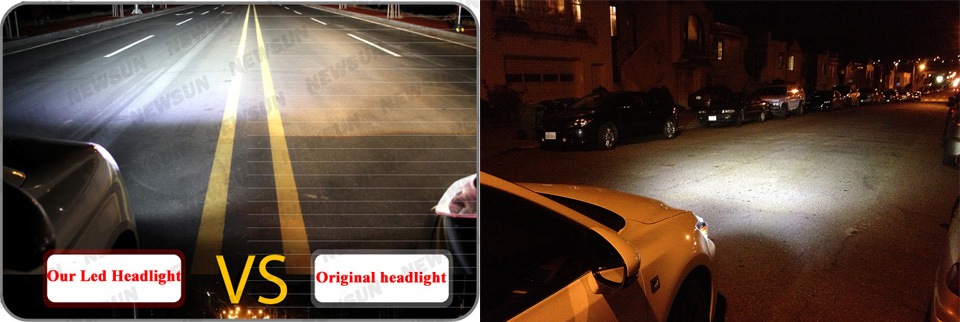
Comparison of H7 LED bulbs in lens
As for the lenses, it's no secret that supporters of such nonsense write that the lens will endure everything, that you can't put it in it. We look at a promising photo:
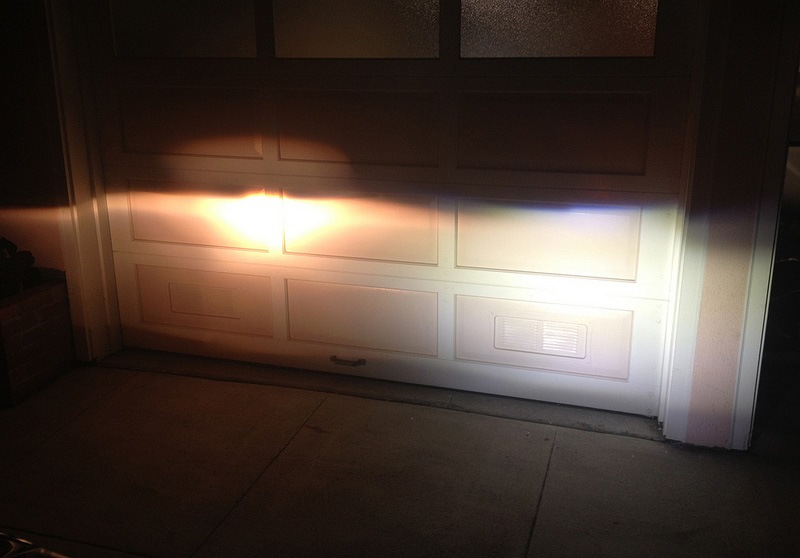
Comparison of H7 halogen lamp and 22W LED lamp in a lens
Where is the light intensity? Halogen lamp brightens up many times LED lamp. And now we look at how lenses with similar lamps shine. Introduction video from IvanASh from this his notes.
and a video by Dmitry Kuleshov where he installed these crafts on a new qashqai, pay special attention to the 5th minute, where you can just see the difference in the intensity of the glow.
And so, if you looked carefully, you noticed that there is no light further than 5-10m at all. If a normally tuned near halogen should shine at 40-45m, and is still normally visible at 30m, then with LEDs the lighting distance is significantly reduced. Move around with them extremely unsafe, especially on unlit tracks, no matter how beautifully outwardly they did not shine.
In the lens, the light at the light-shadow border is formed by parts of the reflector at the base, while the LED lamps shine to the side, which gives a completely wrong picture of the light distribution:

Comparison of the light of LED lamps in a lens
In addition, in order to approach the intensity of the glow to a halogen lamp, LEDs are used to the maximum, while cooling remains to be desired - the maximum that these lamps last is six months. Then the chip degrades, even cracking from overheating. The most important thing is that when overheated, they do not evaporate volatile compounds on the reflector of your headlight, because I would be afraid to even insert something like that into the lens - ventilation is difficult there and all the muck will be well deposited on top - the area responsible for the dipped beam.
An interesting and useful article about such fashionable LED lamps in cars and decided to repost it on my blog.
Pros and cons of LEDs compared to conventional lamps.
Recently, LEDs have become very popular in everyday life, despite the fact that they are at least 10 times more expensive than incandescent lamps we are used to. The main reason for this is their economy. Life time LED lamp can be up to 10 years, and its energy consumption is many times lower than the "classics".
In cars, all these advantages are especially relevant, since the lower the current consumption, the more noticeable the load on the battery is reduced. Yes, and you will have to change burnt out lamps much less often. LED devices today can be found in many foreign cars, even budget ones. For example, they are often used in brake lights, indicators, turn signals and in dashboards. However, along with many advantages, LEDs also have disadvantages. For example, many experts believe that such lamps are harmful to health. So is it worth it to change the standard lamps to LED?
LEDs - good or bad?
Recently, a study by Spanish scientists was published that found that prolonged exposure to LEDs on a person's eyes can cause irreversible changes that can lead to blindness. Due to the peculiarities of the distribution of the light spectrum, LEDs can cause damage to retinal cells.
However, it should be said right away that these studies concern household lamps. The effect of LEDs on human vision in a car is negligible. For motorists who decide to change conventional lamps on LED, there are other arguments against. Firstly, this is a very high price, which exceeds the cost of a traditional incandescent lamp by 10-50 times, so the initial cost of purchasing these lamps will be very high. vk.com/cars.best In addition, LEDs need a rated operating current. In the simplest cases, a resistor solves this problem, and in more complex cases, additional electronic components will have to be installed - current sources.
At the same time, there are many factors in favor of replacing LEDs. Firstly, such lamps serve much longer than traditional ones. They withstand temperatures from -30C to +70C, they heat up much less, consume much less electricity. A properly installed LED lamp is more resistant to vibrations and shocks, which is very important for a car moving on Russian roads.
The LED response time has been calculated to be 200 milliseconds faster than a traditional incandescent lamp. By installing an LED in the brake light, the driver of the next car will notice this light signal and start braking 200 ms earlier. When braking at a speed of 120 km / h, this will give an extra 6.6 m, which will allow you to avoid a collision, at 60 km / h in the city - 3.3 m. Experts say that a well-designed LED from a good manufacturer will last about as long without replacement as the whole car.
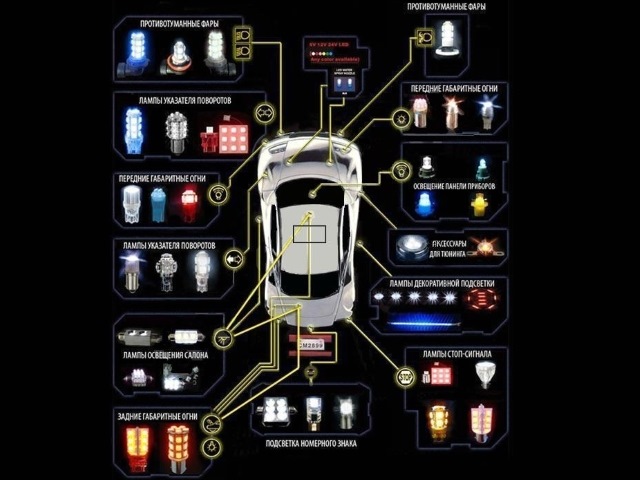
Installing LEDs: where to start?
Experts advise starting with replacing traditional incandescent bulbs with LEDs in dimensions, trunk lights, and glove compartment lighting. It is necessary to look at the bases of the lamps used in the car in order to choose similar, but already LED ones. By the way, at the same time, you can choose the glow temperature, which can be warm white (closer to the yellow glow of incandescent lamps), just white and cold white (it gives off blue).
Is it worth it to replace traditional bulbs with LEDs in low beam and high beam headlights? Someone has already decided on this, but many believe that in this case it is better to trust the "classics". Firstly, the brightness of vk.com/cars.best LEDs may not be enough for headlights. And secondly, even if a solution to the problem of brightness is found (for example, there are offers of such headlights from Hella and Philips), it can turn out to be very expensive, and therefore unjustified.
Recently, the installation of LED strip in the trunk has become very popular. All you need is a regular double sided tape.

Subtleties when installing LEDs
Having decided to replace part of the incandescent lamps in the car with LED ones, you should not rush to the store. The cost of LEDs is quite high, and in this case, it may be quite justified to buy online.
The installation of LEDs in turn signals can lead to the fact that these headlights, due to the nature of led lighting, will flash faster than usual. Experts offer several solutions to this problem. The first is to purchase LEDs with the so-called "dummy resistor". The disadvantage of this option is that the main advantage of LEDs - low power consumption - will be lost. There are other options related to the manipulation of the turn signal relay, but it is better to entrust them to professionals by contacting a trusted service for this.
If the car has an on-board self-diagnosis system, then installing LEDs can activate the burnt out bulb warning function, as the on-board computer will see a decrease in current consumption. In order to remove this signal, you need to connect a diagnostic computer and make adjustments. Or you can just ignore the warning.

In the dry matter
Replacing incandescent lamps with LEDs in a car will reduce the load on the battery of lighting devices by an average of 85%. In addition, you can save on the purchase of the bulbs themselves, which will no longer need to be changed once a year or every six months. LEDs are much stronger than incandescent bulbs.
However, their impact on human health and vision is of concern to scientists. In addition, the scope of their application in the car is not unlimited, and their use in turn signals has its own characteristics. vk.com/cars.best But some of the incandescent lamps in a car can be replaced with LED ones, fortunately, the replacement itself is quite simple and does not require special knowledge.














